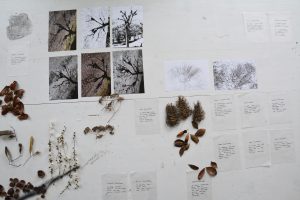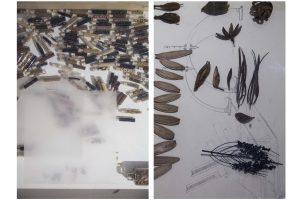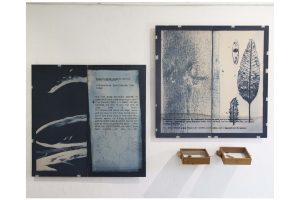
Our eyes have an ability to see order in chaos, catching on to a specific resemblance and in turn simplifying an otherwise complex concept. On the contrary, a schizophrenic experience is one where the form in focus is isolated, becoming ever more material and literal; bordering on the feeling of an intense lack of reality (Deleuze and Guattari). This shift between a sense of absolute reality, and the lack there of when a form is removed from its surrounding noise and retained without any disturbance, is one of the primary ways in which photography as a medium works into my practice.
My practice over the past few years has stemmed from analogies derived from the organic world in relation to its cultural and political implications. In the process of research, interaction and documentation, my active archive (through collection, photographs and drawings) of spaces and objects continues to grow and incorporate histories and presents. Within the media I use – digital and alternative photography, etching, drawing, photographic transfers, molds and casts, and mixed media on the object itself – I constantly attempted to cut out the noise that surrounds a form and isolate it.
This removal of context soon leaned towards strategies that played out as partially escapist, but instead pointed me towards the critique of such a sanitized (in thought) museum space itself. As I had distanced myself from the initial context from which the object was picked, the collection then seemed to develop as a community, with its own connections and dialogue.

The artist serves as the historic agent of memory, while the archive emerges as a place in which concerns with the past are touched by the astringent vapours of death, destruction and degeneration. Yet, against the tendency of contemporary forms of amnesia whereby the archive becomes a site of lot origins and memory is dispossessed, it is also within the archive that acts of remembering and regeneration occur, where a suture between the past and present is performed, in the indeterminate zone between event and image, document and monument.
(Archive Fever, Okwui Enwezor)
As I collect and interact with natural objects and spaces in nature, I have come to question my intervention and its consequences. As I question the premise of museumization and its dialogue with control and violence, there is a constant gnawing which points out that my interaction with the natural world has its own violence attached to it. This extends to the fact that all interaction we may have with what we deem as ‘other’ has an inherent violence.
“Perhaps any archive is founded on disaster or its threat; pledged against a ruin that it cannot forestall”. (The Archival Impulse, Hal Foster)
For example, imperial and colonial archives play a major role in how India as a subcontinent (as well as other colonized states) understood their own natural heritage. The oldest botanical and zoological drawings date back to colonial rule, commissioned to study, understand and in turn control aspects of the new land that they were not yet aware of. Starting with power and its establishment being synonymous with understanding and classification, eventually the need to classify can be seen less as an infliction of power over the other, instead as a way to hold on to one self and what we know/once knew; a barrier to guard against approaching ruin.
Within my practice, the process as well as the end-result is displayed as a collective of media that surround the viewer; turning the act of collecting specimens on its head and looking at it from an evocative and open-ended view. The attempt is to search for ways to visualize and present ideas of ‘protection’, ‘immortalization’ and ‘embellishment’ in dialogue with those of colonization, taming of the ‘other’, ‘wildness’ and violence. The potency of the word taming is one that intrigues me, as it can be defined as a mutual agreement that momentarily allows for a relationship between one and the ‘other’ – bringing both sides to their most vulnerable.
"What does that mean--'tame'?"
"It is an act too often neglected," said the fox. It means to establish ties."
(A Conversation between the Fox and the Little Prince, Antoine de Saint-Exupéry)
In the age of the Anthropocene, a theory arose of which the roots are unknown. While men of science began to vehemently claim that mankind was now the greatest impactor of the Earth, an anonymous voice coined the term the third space. Every action of man is now seen as one side of an intimate dialogue which he is having with nature. Each brick he places at the edge of a river is met by blooms of moss and lichen. A Mughal ruin, once regal and flawless, gradually begins to hear whispers through time of roots and stems.
The third space now puts forth its premise – biodiversity now no longer exists within the depths of the forests or deep in the untouched waters of the rivers, instead the spaces that are rich and precious are the points of such dialogue and conversation between man and nature. These points, are today’s markers for tomorrows history. The in-between.

Looking at natural objects and the communities they form when removed from their original context within the framework of the self and the self-declared other, I began to question the absolute understanding of an object (a scientific botanical drawing for example) and playing with other less authoritative modes of knowledge (myths, beliefs and folklore); a way to maybe utilize language and epistemology in ways outside of what our instinct would be.

Sarasija, I’m very interested in the idea of decontextualization that you present through your study of archival work. I wonder if all art–written, performance, and visual–creates a new context for material by virtue of presentation. For example, when a piece of art is taken out of a studio within an artist’s sanctum and moved into a gallery, it takes on a new life. The piece absorbs the context of the space, the artist’s deliberately tailored statement, the location, the socia-political time period, and even the viewers as they form their own connections to the work. Isn’t the process of isolation and context recreation what provides such interesting discord and discussion surrounding art? The world is not black and white, just as we analyze history from multiple perspectives to not repeat it. I see an artist’s re-contextualization as their conscious or unconscious point of view. Should archival work solely serve the purpose of documentation? Is that ever entirely possible? After all, when we do not witness something first hand, isn’t something inevitably lost in translation? You use the word “violence,” which connotes the negative, but I also see your beautiful creation that follows as a positive.
Uji, yes! The idea of decontextualization does undeniably become a part and parcel of an artistic practice, but the beauty in those varied and subjective readings is two-fold for me.
Just as my praxis itself allows for multiple entry points, and forces me to address as many subjective connotations as possible in order to not fall into the trap that I am questioning at the first place – the absolutistic(forgive the liberty I am taking with the English language) nature of knowledge – the same way my work when taken out of the studio almost seizes to exist without the subjectivity of the viewer.
But yet, there is a reason why I find solace in that decontextualized subjectivity, and it lies in the fact that opens new trajectories for me as well, and pointedly makes me address aspects that I may be consciously negating or subconsciously overlooking. Though I do completely see eye to eye with the view that a viewer is bound to see a work in ways that don’t fall in line with the artists initial impulse, if ten people come and talk to me of a strain of politics, or colonial histories for example, and how they noticed it in my practice, I work towards accepting and slowly manipulating what my work is saying without my knowledge or intention, instead of negating the existence of such thoughts. In a sense, the subjectivity becomes a part and parcel of how my practice grows. Though rather megalomaniacal it may sound, if my practice reiterates certain facts and aspects to the viewer, then I prefer to be able to control in some way what it says, owning the varied interpretations rather than looking at them as notional readings out of my control.
I also agree that multiple perspectives have a beauty in them, and that is in most ways what my work is about; a constant attempt to negate knowledge and fact as singular. Archival work is most certainly not purely documentation, but the intention behind an archive, in its most literal sense, does lie in the fact that it is meant to preserve with factual accuracy. While things lost in translation may or may not be accepted by the one that initiates a dialogue or witnesses an event, there is still the question of whether this decontextualization is in tandem with intention. For a curator working in a museum, the object placed in the glass case, its corresponding placard with details, the files in the cabinets that describe and immortalize it – all are absolute fact. This fact is just as real for the thousands of people walking in to ‘know’ about said object. This is where a dichotomy is inevitable.
Lastly, violence. I do think that the violence for my rests in my process and my handling of the object, my impositions of ideas on it, rather than visibly in the end result. That I guess is the politics of it, that violence can so easily be masked under a parallel impulse of aesthetic resonance. I love that you see it as a positive, often I do too. I guess in a way it acts as both, a critique as well as a threshold.
Thank you so much for your thorough response. I admire how conscious you are of your audience, taking your viewers insights into account and adjusting to ensure that you are conveying your message. The feedback loop and communication is an immersive process, almost like a performance art.
Curators use plaques and dates to immortalize static and objective information; archives are also required to convey subjective material. Breaking down a rendition to a detailed level will help create a precise replication, but like you said, you inevitably focus on preserving particular aspects and become oblivious to others. Alternatively, the other features even seem obvious within the context and don’t seem missing until that context is removed. Constant comparison to the original and duplication may increase accuracy. Perhaps archival work is also more accurate through collaboration as different archival artists will focus on different details, and thus, the culmination is a more complete portrayal, inclusive of the original context.
I’m curious to hear your thoughts on an encounter of mine. A few days before New Year’s, I sat in a cozy seat in a warm London pub, a hot cider in my hand, on a cold winter night. I experienced the sights, sounds, smells, tastes, and touch of the place. To document the scene, I photographed the space surrounding me. Photographs, though they have a limited physical scope and flatten three dimensions into a plane, are often considered to be precise reproductions. I later decided to paint the memory from the photo, but ended up deviating from that physical “copy”. In the image, the lights were to harsh, the sheen of the leather too stark, the warm air absent, and the sounds and smells of holiday cheer amiss. Thus, I relied on my memory of what I experienced that night. Was my painting only an authentic portrayal of my memory and the photograph was the factual representation? Which is the more accurate preservation of the night itself?
It can be argued that the photograph reduces the space for human error in altering the original setting. However, I feel that my painting added more context from the scene than the photograph did, making it a stronger archival piece. In the violence of altering the image, I produced a rendition of that night. Even our perception of what we unconsciously destroy for our depiction is missing context. I agree that there is creation born out of destruction. On what basis do we determine which is more accurate: the destroyed, with its missing pieces, or the created, with its added context?
The thorough comments and responses help me just as much!
I seem to have positioned my argument a little bit awry. My practice, and in some ways my way of both research and display, are not aimed at making archiving more accurate. In fact, I think the ‘inaccuracy’ and ‘subjectivity’ or knowledge is so much more relevant to how we understand our world than pure measures and historical data.
My work is quasi-archival, where if I pick an object then the narrative that begins to build up takes just as much from mythology, aesthetic impulses and fiction as it does from science. In that sense, I wholly agree that the painting captured the essence so much more than a photograph. For you, it captured all you needed it to, and the photograph didnt.
I do feel that human error, notional and fictional narratives, superstition, missing pieces – each has a part to play in how something is read. In fact that has become my mode of functioning as well – keeping each of these intact as points of departure open for interpretation, in an ‘archive’ that is open for interpretation.
When it comes to your question of if the photograph is more or less factual than the painting, that binary is exactly what I am hoping to critically look at. Choosing either one as ‘true’ makes it a form of absolution. It becomes a way to establish that is the ‘right’ way. In today’s knowledge structures, that power is in general held by science, or ruling authorities. In the process, so much is lost – from simple beliefs in our own ancestry that held within it so much fact that was then not wholly understood, to ritualistic folklore that idolizes forms in a seemingly ‘pagan’ manner, which may act as protection or lend monumentality.
Any one tangent scene from a single perspective becomes a shift in context, especially since context itself is subjective from person to person and perspective to perspective. “In the violence of altering the image, I produced a rendition of that night.” That statement itself has so much meaning! I find it hard to ask a question such as ‘on what basis do we determin which is more accurate’, when the beauty may actually lie in all at once – the destroyed, the missing pieces, the altered and manipulated creations as well as aesthetic ‘true’ forms.
Thankyou Ushmita, Anthony Downey’s book might be a relevant one for me to look at as well!
The decontextualization, displacement and deterritorialization within my practice is one becomes my point of departure to be able to weave a narrative, a narrative that allows me to now recontextualize and reterritorialize the given displacements. I think I have begun to look at my archive as one that is active for this reason, where I am bound by the idea what the displacement is inevitable – even if I choose to not pick an object up but only draw or photograph it where it is found.
That inevitable displacement is what has in some ways lead me to look at alternative sources of knowledge and paradigms as a way to give these displaced objects and images a new story, a new community to exist in and in a way a life story outside of the scientific, but without disregard for it.
About the Botanical drawings in Mughal times, yes I have read up on them and their archives as well, and there was immense care that the rulers (particularly Babur and Aurangzeb) lent to both botanical and zoological forms, but I am using colonial studies as my anchor because the approach in both was rather different.
If the historical relevance is seen in terms of conscious and subconscious creation of archives, the colonial records become a starting point for how we today see our surroundings. No doubt that the Mughal’s have an undeniable impact on our history and our present, but a certain discounting is yet possible, seeing as concretization and systems that we see today bank on how the West started it off for us.
Though I’m very glad you brought it up, because that does give me yet another trajectory where archives do often lean back to ‘outsiders’ and their instinctive way of understanding what is outside of them.
Hello, Sarasija. In his book Dissonant: Contemporary Visual Culture and Contested Narratives in the Middle East, Anthony Downey states that archives and the artists who work with it, enter into a pact of sorts that presents archives as a limitless and ordered field of research, and, contiguously, an epistemically unstable source that is liable to imminent collapse if not total disappearance. Although he is talking specifically of photographic archives, An archive automatically, by its very nature decontextualises and displaces that which is archived, while creating newer contexts and associations. In that sense, it would be interesting to know more about and understand how you reconcile provenance or source, displacing and re-contextualization within your practice.
A small corrigendum, Botanical drawings in India can be traced back to Mughal times. You may consult The Art of Botanical Illustration: An Illustrated History By Wilfrid Blunt, William Thomas Stearn, to learn more about this.
Sorry about the slight breaks in formatting!